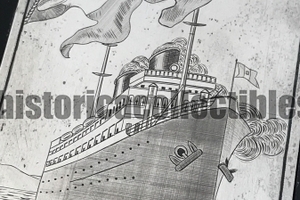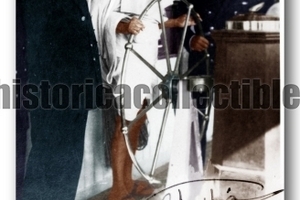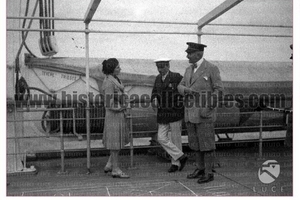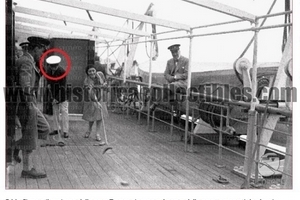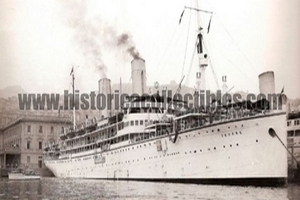Giuseppe de Luppis, Captain Ship Baron Gautsch, Ship Tevere, Ship Pilsna 1914, 1928, 1931
Engraved silver plaque applied on black marble, donated to the Commander of the Tiber Ship Giuseppe de Luppis, by Lloyd Triestino in memory of his 100th voyage made with the steamer "Tevere" on the Trieste-Egypt line in 1928, created by Mario Buccellati, one of the most renowned jewelers in the world.
Giuseppe de Luppis, was embarked as first officer on the passenger steamer Baron Gautsch in 1914, on which he found himself facing the great shipwreck of that same ship, so much so that it went down in history as the sinking of the Titanic in the Adriatic, where over 200 people perished .
De Luppis, after a long trial lasting nine years, was acquitted of any guilt initially attributed to him. Fully rehabilitated, he later had command of the passenger ship "Tevere" (formerly Gablonz), after the First World War. During 1920, the steamer returned to regular service on behalf of Lloyd Triestino on the Trieste-Venice-Brindisi-Suez-Aden-Bombay route and, on this ship, de Luppis achieved this commemorative plaque for the 100th command trip on that route.
Furthermore, thanks to photographic documentation from the Istituto Luce, it was possible to trace the fact that, in the same year as the awarding of the Plaque, de Luppis had the pleasure of including Edda Mussolini among his passengers, with whom, as some photos testify, they talk and play a curious pastime of the time.
Subsequently, Giuseppe de Luppis was Commander of the passenger steamship Pilsna also owned by Lloyd Triestino which became a point of reference for passengers who wanted to undertake journeys on large and luxurious steamships: the so-called "Liners", which were appreciated by a class of clientele, lovers of luxury, comfort, refinement and the services of the Triestina Navigation Company.
Likewise, the Pilsna steamer (with Giuseppe de Luppis in command) was made famous for having hosted on board, in 1931, Mahatma Gandhi traveling from Brindisi to Bombay, returning from the Round Table Conference in London, during which he was tempted to discuss the future of the English colony 8.
Furthermore, during the brief stop in Rome for an unofficial meeting with Benito Mussolini, Mahatma Gandhi chose Lloyd's steamers to return to India.
This news received widespread coverage in the Italian press. In the imminence of his arrival, for example, a paragraph in the Trieste newspaper «Il Piccolo» informed of Gandhi's decision to travel on the Lloydiano steamer «Pilsna», departing from Trieste on 12 December.
According to the testimony of Massimo Affatati, an officer from Trieste, the commander of the «Pilsna», Giuseppe de Luppis, aware of the Mahatma's reservation for bridge passage only for himself and second class passage for his entourage, nevertheless offered Gandhi a seat in first class cabin; he politely declined, preferring to travel up the stern hatch in a tent he had brought with him.
The only convenience that Gandhi accepted was to use the first-class bathroom, near the hatch where he chose to stay. This concession provoked complaints from some English passengers who complained about the "encroachment" within the limits of first class.
On that same trip the «Pilsna» also hosted the Hindu Vithalbai Patel, brother of the more famous Sardan Patel, then Interior Minister of the Indian government in the Congress, the closest in ideas to Mahatma Gandhi, and Professor Masani, a Parsi teacher of oriental languages at Elphinstone College, Bombay.
Among the passengers, Affatati was struck by the sumptuous presence of princes Azzam Jhah and Muazzam Jhah, sons of the Nizam of Hyderabad, one of the most powerful and richest sovereigns of India, with the wives of the Ottoman dynasty and all their entourage.
A group of around thirty people embarked in Venice with a considerable amount of luggage in tow. Unaware of Gandhi's presence on board, when they learned of his embarkation they even threatened to leave the «Pilsna», hostile as they were towards the Mahatma, who they saw as a danger to their autonomous power as he was capable of awakening the Hindu mass in antithesis to Muslim power.
Affatati recalls that only the diplomatic skill of commander Giuseppe de Luppis managed to avoid the "escape" of the Court of Hyderabad.
Steamship Baron Gautsch:
The Baron Gautsch was a steamship belonging to Lloyd Austriaco and followed the route between Lussingrande and Trieste. She was built in Scotland in 1908 in the shipyard: Gourlay Bros & Co. Ltd – Dundee, she had a tonnage of 2069 tons. During the First World War the steamer was temporarily requisitioned by the Austrian Navy to transport troops from Dalmatia to Trieste. That last voyage of hers was the first after she had returned to being a passenger steamer and the military commander had been replaced by a civilian one.
At 11.00 on 13 August 1914, the Baron Gautsch set sail from the port of Lussingrande, headed towards Trieste, with many passengers (from 280 to 350) who escaped the war, for reasons never well ascertained, it entered the minefield placed to defend the port of Pola and hit a mine.
The sinking, described in various books and documents, caused many victims, the number of which could never be ascertained with certainty as there were many soldiers on board who were transferred and traveled without a regular ticket. 178 people were saved, including 41 crew members, and around fifty bodies were recovered.
Heavy accusations fell on the crew, who almost entirely survived: many lifeboats had not been lowered into the sea due to their poor maintenance and the life jackets were locked in the lockers, because they wanted to prevent the third class passengers from using them as pillows during the trip.
Ultimately the crew was accused of thinking about saving their own skin instead of thinking about the passengers (many women and children). The officers under investigation were then all acquitted and continued their careers without any consequences.
Tiber steamer:
The Nave Tevere (formerly Gablonz) was a hospital ship of the Royal Navy, formerly an Italian (previously Austro-Hungarian) mixed steamer.
Launched in May 1912 in the San Rocco shipyard in Muggia, the ship was completed in February 1913, entering service the following month for Lloyd Austriaco, based in Trieste.
Originally named Gablonz, the unit was originally a mixed steamer of 8289 (other sources 8448) gross tonnage, with a capacity of 210 passengers (180 in first class and 30 in second). Like her sister Marienbad, the Gablonz was assigned to the luxury line to India: in March 1913 she left Trieste on her maiden voyage, during which she touched at Venice, Brindisi, Suez and Aden, finally arriving in Bombay.
After just one year of service, in 1914, following the outbreak of the First World War, the Gablonz was disarmed in Lake Procliano, in Dalmatia (north of Sebenico), together with other vessels of the Austrian Lloyd.
With the conclusion of the conflict, in November 1918, the dissolution of the Austro-Hungarian Empire and the annexation of Venezia Giulia to Italy, Lloyd Austriaco became Lloyd Triestino (first, on 3 January 1919, as the Lloyd's Shipping Company in Trieste, then as Società anonima di Navigazione Lloyd Triestino): after having temporarily raised the inter-allied flag, the Gablonz definitively passed to Italy in 1919 or 1920, being renamed Tevere and registered with serial number 481 in the Maritime Compartment of Naples.
During 1920 the steamship returned to regular service on behalf of Lloyd Triestino, on the Trieste-Venice-Brindisi-Suez-Aden-Bombay route. In 1932 the ship was transferred to the Trieste-Venice-Brindisi-Piraeus-Constantinople route, passing through the Corinth Canal.
Pilsna steamer:
Designed and ordered by "Österreichischer LLoyd" ("Lloyd Austriaco" later "Lloyd Triestino") and ordered from Cantiere San Rocco di Muggia (Trieste) in 1914. It was laid down with the name "Pilsna" with construction number 30.
On 19-03-1914, launched on 05-05-1916, on 23-12-1916 transferred to Trieste at the Lloyd's Arsenal for fitting out. Substantially laid up during the First World War, she was completed and delivered to Lloyd Triestino on 18-03-1919 when she entered service. Her tonnage was 6,843, length 131.90 m, width 15.60 m, draft 7.73 m, she was powered by 2 triple expansion reciprocating engines, 2 propellers, 4600 horsepower per axis.
From July 1919 the "Pilsna" was used on the Trieste, Venice, Brindisi, Port Said, Aden, Colombo, Penang, Singapore, Shanghai, Kobe, Yokohama line. Between 18/3/1919 and April 1921 she flew the inter-allied flag. After which she was placed under the Italian flag. In September 1923 she was converted for oil burning.
Famous for having hosted celebrities of the time on board, such as Mahatma Gandhi in 1931, traveling from Brindisi to Bombay, returning from the Round Table Conference in London, during which he was tempted to discuss the future of the English colony 8.
From June 1932 it was placed on the Italy-Istanbul line. In 1934 the arrangements for the Palestine Migration Service were modified and the capacity was increased to 440 passengers in 3 classes.
On 16/2/1935 she was renamed "GALILEA" and with this name placed in service on the migratory line between Trieste and the ports of Palestine. You were also registered as belonging to "Lloyd Triestino Flotte Riunite-Trieste". On 1/1/1937 you were registered as belonging to the newly established "Adriatica" S.A. of Navigation - Venice and remained in service on the Palestine line. On 25/1/1940 she was disarmed in Trieste and on 10/4/1940 chartered to Lloyd Triestino for government transport.
On 11/14/1940 after Italy entered the war, she was returned to the Adriatic and then, immediately afterwards, requisitioned and used as a troop transport for Albania and Egypt. On 28/3/1942 she left with troops from Piraeus for Patras and Bari but unfortunately she never arrived at her destination. In fact, on 3/29/1942 she sank in the Antipaxos Channel after being torpedoed by the British submarine "Proteus". 1041 people perished.


